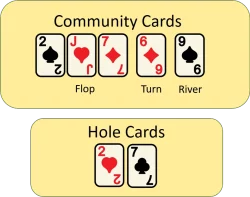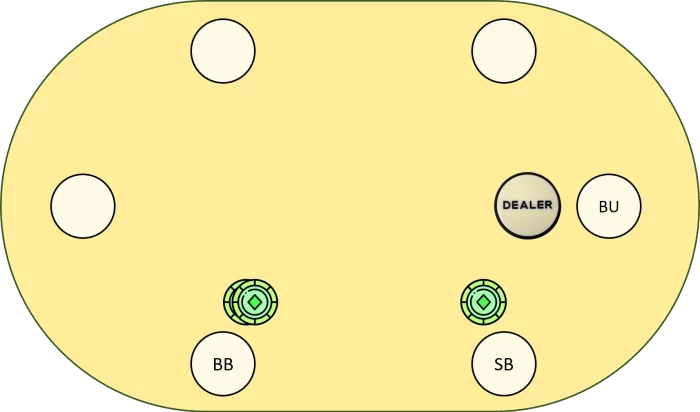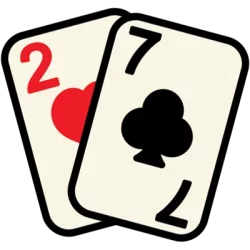This article explains basic Texas Hold’em Poker Rules, and gives examples of play and simple strategy advice. The rules in this article cover Online Texas Hold’em and Live Texas Hold’em.
Texas Hold’em Poker is one of the most popular card games in the world and the poker rules are really easy to learn. Surprisingly, many websites and poker guides fail to explain the rules in a beginner-friendly way for players who are not familiar with the technical terms of the game and have no experience playing poker.
This guide will explain Texas Hold’em poker rules in a beginner-friendly and quick way, without much ado and technical jargon. After reading this guide, you can start playing right away in just a few minutes.
The Most Important Texas Hold’em Poker Terms

Those are the most important Texas Hold’em Terms that we will be using in this poker rule guide. All of them will be explored in more detail below.
- All-In: All-In means betting (or raising or calling) all your remaining chips.
- Bet: A player’s opening wager in a betting round is called the bet.
- Betting Round: Texas Hold’em has four betting rounds: Preflop, Flop, Turn, and River.
- Blind: Small Blind and Big Blind are the minimum bets before cards are dealt. They are placed by the players to the left of the dealer.
- Button: Short for “dealer button” – a specially marked chip that indicates which player will be dealing the cards in the current game round.
- Call: To “call” means to match a bet that has been placed.
- Check: Pass the action to the next player without placing a bet. A check is only possible if no bet has been made before.
- Flop: The first three community cards that are revealed to all players in Texas Hold’em.
- Fold: Giving up on the hand, forfeiting all previous bets.
- Preflop: The stage of play before the flop is dealt.
- Raise: Raise the opponent’s bet by a certain amount.
- Re-raise: A re-raise is a raise made after a raise.
- River: The fifth and final community card.
- Showdown: The revealing of the players’ cards after the last betting round.
- Turn: The fourth community card.
We have listed more than 100 poker terms in our extensive Poker Glossary.
Before the Game Starts
First, here are some general things to consider when playing Texas Hold’em. Before you start playing at home, you need to make some preparations which are explained below. If you play online poker, you can skip this step.
Game Variant: Texas Hold’em

Texas Hold’em Poker is the most popular variant of the game. Thus, online poker sites and casinos mainly offer tables and tournaments in this variant.
Chips: Betting with Poker Chips

Chips are small tokens that have different values. These chips are used to place the bets at the table. When playing for real money, players purchase chips when they buy into the game and exchange the chips for real money when they leave the game. In tournaments, each player receives the same number of chips at the beginning.
Players: 2-10 Players per Table

At least two players are required to play Texas Hold’em. As a rule, a maximum of 10 players play at one table. It is possible to squeeze more people into one game, but the game is less fun with that many people and most online casinos and card rooms nowadays cap the game at 9 players per table.
Cards: A Deck of 52 Playing Cards

You need a poker deck with 52 playing cards. Remove the jokers so that only cards Deuce through Ace are available in all four suits (spades, hearts, diamonds, clubs).
Stake: The Initial Stake Must be Set Before the Game

When playing Texas Hold’em (or most other Hold’em Poker games), the stake is determined by the so-called blinds. Blinds are forced bets that two players at the table must place before each round begins. There’s the big blind and small blind which is usually half the value of the big blind. We will explain this concept in detail later.
The value of the blinds can be used to estimate roughly how high the stakes will be. When playing a cash game for real money, players usually begin with 20 to 200 the amount of the big blind. Say you’re playing a home game with $0.25 / $0.50 blinds, players will usually buy in with chips worth $10 up to $100.

Dealer: Choosing a Dealer
The dealer is the person who deals the cards at the table. He is the last to act in (almost) every round. For each new hand, the player to the left of the previous dealer becomes the new dealer.
When playing Texas Hold’em Online or in a casino, the actual dealing of the cards will be done by a computer (when playing online) or a professional dealer (in a casino). Nevertheless, a virtual dealer is assigned each round and they have a small dealer button as an indicator.
Basic Texas Hold’em Rules and the Aim of the Game
When playing a hand of Texas Hold’em the gameplay is divided into four so-called betting rounds during which cards are dealt and bets are made.
Hole Cards and Community Cards

During one hand of Texas Hold’em, each player receives two cards face down, which can be used only by him. Those are called hole cards. In addition, five community cards are placed in the middle of the table, which can be used by all players. Those are called community cards. Thus, every player has access to seven cards. When a hand goes to showdown (meaning, more than one player is left after all betting rounds are over) each player shows down his hole cards and determines the best 5-card combination of his two hole cards and the five community cards. A player can use two, one or none of his hole cards. The player who has the best hand, wins all the chips in the middle.
We will explain the ranking of all possible poker hands later or you can find detailed rankings on our Poker Hand Ranking Page.
How to win a hand of Texas Hold’em
A player has two ways to win a hand in Texas Hold’em:
- They are the last player who still has cards.
- They show down the best hand at the end of the hand.
Actions During One Betting Round
One hand of Texas Hold’em Poker consists of four betting rounds. Cards are always dealt first before the bets are placed.
In each betting round, players have those betting options available:

Check
If no bet has been placed yet in a round, a player has the option to check. By doing so, they pass on to the next active player to their left without betting anything. Checking is often times indicated by simply knocking on the table.

Call
If a bet has already been placed in this round, a player has the option to call. This means that they settle the bet of the opponent to remain in the game.

Bet
If no other player has placed a bet before in the round, a player can place a bet when it is their turn. The bet must be at least as much as the big blind.

Raise
If a bet has been placed, a player has the option to raise this bet and increase the wager. The raise must be at least double the original bet.

Fold
A fold is always available when there was a bet or raise. It means that the player does not want to call an opponent’s bet or raise. If you fold, you give up the hand, surrender your hole cards and forfeit all chips you have wagered during that hand.
Gameplay – Texas Hold’em Betting Rounds
Now that we know the possible actions, let’s take a look at the four different betting rounds.
Pre-Flop: Blinds and Hole Cards
The first Texas Hold’em betting round is before the first community cards are dealt and is called “pre-flop”.
Posting of the Blinds

First, the blinds must be posted before the dealing of the cards begins. The player sitting to the left of the dealer must pay the small blind and the player to the left of this player must pay the big blind. Both players place the bets in front of them towards the middle of the table.
The value of the blinds was determined before the game. As a rule, the big blind is twice the amount of the small blind.
In online poker, table designations such as “Texas Hold’em No Limit 0.25/0.50” are common. This means that the small blind (or short SB) is 25 cents and the big blind (short BB) is 50 cents.
Dealing of the Cards
Once the two players have posted their blinds, the dealer begins dealing each player two cards face down, the hole cards.
Bets
After the cards are dealt, the player to the left of the big blind is the first to act. This player has several options: pay the big blind (call), raise to at least double the big blind or fold.
In turn, the action moves clockwise and all players place their bets or fold until all bets are completely balanced, i.e. all players who want to stay in the game have bet the same amount.
Note that it is possible for a player who has raised to be outbid by a subsequent player and having to pay this bet in order to remain in the game. Once all players have placed their bets and matched the highest raise, the betting round is over. All bets in front of the players are moved into the middle of the table (they constitute the so-called pot) and the next betting round commences.
Flop: 2nd Betting Round

After the pre-flop action is over, three cards are dealt face-up in the middle of the table. Those three cards are called flop.
After the flop is dealt face-up, there is another round of betting. Now the betting starts with the first active player sitting to the left of the dealer. All players who have previously folded cannot participate in the action during this hand anymore.
Starting in the second betting round, players now have the option to check, bet, call the bet of another player, raise (or re-raise) or fold.
Once all players have either matched the highest bet of a player or folded, the betting round is over and all chips that were bet in this round are put in the pot.
Turn: 3rd Betting Round
After the flop action is over, the next betting round begins and now a single card is placed next to the three cards in the middle of the table face-up. This is called the turn.
The game proceeds as before. The remaining player who sits closest to the left of the dealer starts the betting and has the option to check or bet. Depending on their decision, all subsequent players have the option to check, bet, raise or fold. Once all the bets are matched and if there are still two or more players remaining, the chips are put in the pot and the game continues.
River: 4th Betting Round
Now a fifth and final card is placed face-up in the middle of the table, the so-called river.
After the river has been dealt, a final betting round begins which has the same rules as the betting rounds on the flop and turn.
Going to Showdown

If there are still two or more players in the game after the river, the hand goes to showdown. This means all remaining players have to reveal their hand, i.e. their two hole cards and the best poker hand wins.
The winner receives the entire pot – all bets that have been accumulated in the middle during all the betting rounds of this hand. In case there is a tie (when two players have the same winning hand), the pot is divided equally among all the players with the best hand.
Play Texas Hold’em Online
Now you know all the important rules of Texas Hold’em. It is easiest to practice playing Texas Hold’em Online. You can start with play money to get a feel for the. We suggest you try one of those sites to start playing:
» Full list of the best Online Poker Sites
Texas Hold’em Hand Examples
Let’s add some meat to the dry rules and show you some examples of Texas Hold’em Poker Hands. Click on the hand to reveal the action.
Hand 1 – Getting Lucky on the River
We have four players in a friendly home game – Phil, Daniel, Vanessa and Jennifer. They’re playing $0.50 /
Phil is the dealer. Daniel places the small blind ($0.50) and Vanessa places the big blind ($1.00). Now all four players receive two cards each.
Preflop: Raise with an Ace
Jennifer is the player to the left of Vanessa and since Vanessa is the big blind in this hand, Jennifer is first to act. She looks at her hole cards: A♣5♣. If she wants to remain in the hand, she must at least match the $1.00 big blind. But Jennifer decides to raise to $3.00 as her two cards are quite decent.
Phil is next to act and he looks down to see 8♣4♥. This hand is garbage and he quickly decides to fold. Next to act is Daniel in the small blind. He holds a small pair with 4♥4♦ and elects to call Jennifer’s raise. Since Daniel already has $0.50 in front of him (his small blind), he only has to call $2.50. Vanessa in the big blind picks up two big cards: K♦Q♠. She too decides to call as well and since she already has the $1.00 big blind in front of her, she has to pay $2.00.
Now all three remaining players have $3.00 in front of them and the betting round is over.
Flop: Almost a Flush
The flop is dealt and the three cards in the middle are K♣7♣6♥.
The first player to act is Daniel in the small blind. While he has a pair, his hand is very weak and he elects to check. This means, he doesn’t place a bet and the next player can act. He can do this because no bets have yet been placed in this betting round.
Next to act is Vanessa. The best hand she can make right now is a pair of kings (with the one king from her hole cards and the one king from the board) – a decent hand. But Vanessa also elects to check.
Now it’s Jennifer’s turn. She has two clubs in her hand and the flop also shows two clubs. This means she has four cards to a flush or a so-called flush draw. If the turn or river bring another club, she’d have a flush, a very strong hand. Thus, she decides to bet $6.00. (If you want to know how likely it is for a flush draw to be completed, check our Texas Hold’em Odds and Probabilities).
Now the action is back on Daniel. To stay in the hand, he’d have to match the bet. But he elects to let go of his hand and folds. Now only Jennifer and Vanessa remain in the hand.
Vanessa elects to call the bet and pays $6.00.
The bets are collected, placed in the middle and the next community card, the turn is dealt.
Turn: A Bluff with a Draw
The dealer places the turn card, the 2♥ next to the flop.
It’s Vanessa’s turn and she decides to check, meaning she places no bet and it’s Jennifer’s turn.
Jennifer now could also decide to check and then the betting round would be over and the final card would be dealt. But Jennifer elects to bet again, despite her hand not having improved. She bets $15. Right now, Jennifer only has ace-high – most likely not the best hand. But she hopes that Vanessa gives up her hand and that she wins the pot right there. In case Vanessa calls, Jennifer still can win if a good card (a club or an ace) peels off on the river. This move is called a semi-bluff – you bet (or raise) with a weak hand, hoping that all opponents fold. But in case they don’t all fold, the hand has some potential to improve to a strong hand.
To stay in the hand, Vanessa has to call the $15 bet. She is still holding a pair of kings which is the highest possible pair with the cards on the board – called top pair. This is a fairly strong hand and thus she calls the bet.
River: Lucky Ace
Now the river is dealt: the A♦ is placed next to the other four community cards.
It’s Vanessa’s turn and her top pair just got demoted. That’s why she checks for a third time this hand.
Jennifer now has the option to bet. She just made a pair with the ace on the river, but she assumes that Vanessa will probably not call her bet if she has a worse hand. Thus, Jennifer checks as well.
Now it’s time for the showdown. Both players open their hole cards.
The best five-card combination Vanessa can make with her hole cards and the five community cards is with K♣Q♠ from her hole cards and A♦K♦7♣ from the board. Thus, her hand is K♣K♦A♦Q♠7♣ – a pair of kings.
Jennifer’s best five-card combination is with A♣ from her hole cards and A♦K♦7♣6♥ from the board. She only uses one of her hole cards and her hand is A♣A♦K♦7♣6♥ – a pair of aces.
Jennifer got a little bit lucky on the river and wins with her better pair. She collects the entire pot worth $51.
Hand 2 – A Quick One With no Flop
For the next hand, the dealer position and with it the small and big blind positions rotate one position clockwise.
In our example, this means Daniel is the dealer now, Vanessa has to place the small blind ($0.50) and Jennifer has to place the big blind ($1.00).
Every player receives two cards each and the first player to the left of the blinds, Phil, has to act first.
Phil looks down and sees 7♣2♦. This hand is considered the worst hand in Texas Hold’em. The two cards are not connected, don’t share a suit and are very low. In fact, this hole card combination is so bad that it’s nicknamed “beer hand” – a hand you don’t play, but where you get up from the table to get a beer from the bar.
Next to act is Daniel and he finds 8♠7♠. His hand is connected and the two cards share the same suit. Hole card combinations like this are called “suited connectors” and are quite decent as they allow you to make a flush or straight with the right community cards. Daniel elects to raise to $3.00.
Vanessa in the small blind looks down at her cards – K♦6♠. While the king is a decent card, the lone six is almost worthless and this hole card combination is generally very bad. She folds.
Last to act is Jennifer in the big blind. She holds J♥5♥. The two cards share the same suit (called “suited”), but apart from that, the hand doesn’t have much going for it. Jennifer also decides to not play this hand and folds as well.
Thus, Daniel wins this hand without a fight as all his fellow players have folded. He collects the pot worth $1.50 and the next hand is dealt.
A hand like this one is very common, especially when playing Online Texas Hold’em. Most hole card combinations in Texas Hold’em are not very good and quite frequently no player has a particularly strong hand before the flop and the most aggressive player wins the hand with a single raise.
Hand 3 – Bluffs on the Flop
Let’s look at one more example hand. Now Vanessa is in the dealer position, Jennifer posts the small blind ($0.50) and Phil posts the big blind ($1.00).
Preflop: Playing With Mediocre Hands
Daniel is first to act and finds Q♣T♥ – a somewhat decent hand with some potential. He raises to $2.50, slightly more than the smallest allowed raise size.
Behind him, Vanessa picks up 9♣7♣ – a suited hand that is somewhat connected. She decides to call the raise.
Jennifer in the small blind has J♠6♦ – a worthless hand that she quickly folds.
Phil in the big blind holds K♥5♥. His hand is not very strong, but he only has to pay $1.50 to see a flop, thus he calls the raise.
Flop: Double-Bluff to Take it Down
Three players see a flop and the dealer fans A♣8♦5♣.
Phil is first to act and although he has paired his five, he elects to check.
It is Daniel’s turn next and his hand has not improved at all. Nevertheless, he decides to bluff. As he was raising preflop, he tries to represent a strong hand, for example, a pair of aces, by betting $6.
Vanessa behind him right now has no good hand to showdown. But her hand has a lot of potential. Any club would give her a flush and any six would give her a straight. This is called a “combo draw” and is a hand with plenty of potential. Vanessa elects to run a semi-bluff with this hand and raises to $18 instead of just calling. By raising she gave herself two ways to win this hand. She’ll win if nobody calls her raise and she’ll (probably) win if she improves her hand on the turn or river.
The action is on Phil again; to stay in the hand, he has to call $18. Right now, he has the best hand of all players at the table with his pair of fives, but he cannot know that and thus he folds his hand.
Daniel, who bet on the flop, now either has to call the raise (and put another $12 in the middle) or he can fold. He tried to bluff when he bet the flop, but his hand has no value or potential. Thus, he just folds.
After Daniel’s fold, everyone but Vanessa is out and she wins the pot on the flop without a showdown. She collects $31.50 and the hand is over.
Three Ways for Poker Hands to End
A hand in Texas Hold’em Poker can end in three ways.
a) All Opponents Fold

If a player has bet or raised in any betting round and no opponent wants to call, the player automatically wins the pot. This end to a hand is by far the most common in Texas Hold’em.
b) Showdown

If there are at least two players in the hand until the last round of play is over and all bets are matched, the player’s hands are turned face up on the table and the best hand wins.
c) All-In

In Texas Hold’em it’s possible for one player (or even more players) to be all-in in a hand. This happens either when the player bets or raises all their chips or when they call a bet or raise that was larger than their remaining stack.
An example of the latter happening would be if Player A bets $60 on the turn, and Player B calls, but they only have $40 remaining. Player B doesn’t have to take out their wallet to match the bet (in fact, it’s not allowed to add chips to your stack during a hand), but they call only $40. Player A takes back their excess bet, in this case, $20 and player B is all-in.
If a player is all-in, he can no longer bet, raise, call or fold and they are guaranteed to go to showdown.
If three or more players are still in the game and only one goes all-in, a side pot is formed. The player who went all-in can only win this pot and keeps his cards face down in front of him, even if he can no longer influence the rest of the game. The remaining players continue to play as normal until all but one fold or a showdown occurs. These players can win the main and side pots, the player who went all-in can only win the main pot he contributed to.
Poker Hand Ranking
Once you have internalized the Texas Hold’em Poker rules, it is important to familiarise yourself with the value of a poker hand. You should always be able to tell if you are holding a good and promising hand so that you know whether it is worth betting or calling an opponent’s bet.
At the same time, you should be able to assess what kind of hands the community cards in the middle allow, so that you know approximately what kind of hand your opponent might hold and whether it is capable of beating your hand.
Below you will find the poker ranking according to the Texas Hold’em rules:
High Card
If you have no special poker hand (e.g. pair, straight or flush), the highest card is counted. If it comes to a showdown and none of the competitors has a pair or any better combination, the one with the highest card wins. The value goes from 2 as the lowest to Ace as the highest.
Example: A♥K♦7♣6♣2♥ beats A♦Q♦J♥T♣8♥
One Pair
A pair means that in your five best cards there are two cards of the same rank, for example, two Queens. If more than one player has a pair, the rank of the pair counts. If two or more players have the same pair, the so-called kicker, i.e. the highest additional card, counts. If this is also the same, the second-highest additional card counts, and so on.
Example: K♥K♦Q♦4♣2♠ beats K♠K♣J♥9♠8♠
Two Pair
If you hold two pair, you have two cards of the same rank twice in your hand, for example, two Aces and two Eights. If two players have two pair, the player with the highest pair wins. In case both players hold the same high pair, the player with the highest lower pair wins. In case two players have the same two pair, the player with the highest side card (i.e. kicker) wins.
Example: A♣A♠8♣8♠Q♦ beats A♥A♦7♦7♣K♥
Three of a Kind
Three of a kind means that you have a total of three cards of the same rank, for example, three queens. Again, the higher three of a kind wins and if the three of a kind are the same, the highest side card counts.
Example: 9♣9♠9♥A♦2♣ beats 9♣9♠9♦K♥Q♦
Straight
To make a straight, you need five cards of consecutive ranks, for example, 5-6-7-8-9. The suit of the cards does not matter. In a straight, it’s possible for an Ace to be counted as either low or high. Meaning, A-2-3-4-5 is a straight and T-J-Q-K-A is a straight as well. The Ace cannot go in the middle of the straight though. For example, Q-K-A-2-3 is not a straight. If two players have a straight, the player with the higher straight wins.
Example: J♣T♦9♠8♥7♦ beats T♥9♥8♦7♣6♦
Flush
A flush is higher than a straight and is a combination of five cards, all of the same suit, regardless of the value of the cards. If you have five clubs, diamonds, spades or hearts, you hold a flush. If there are multiple flushes at the table, the flush that includes the card with the highest rank wins. If this card is the same for both players, the next highest card counts, and so on.
Example: A♥K♥T♥9♥8♥ beats A♥Q♥J♥9♥8♥
Full House
When you hold a full house (also called “boat”), your hand is made up of a pair plus three of a kind, for example, three Queens and two Kings. If two players have a full house, the player with the higher three of a kind wins. If both are the same, the player with the higher pair wins.
Example: K♥K♦K♣Q♦Q♥ beats K♥K♦K♠J♠J♣
Four of a Kind
A four of a kind (also called “poker” or “quads”), consists of four cards of the same rank, for example, four aces. If two players hold the same quads, the player with the highest side card (kicker) wins. Two players holding the same quads is possible in Texas Hold’em only if the board shows quads.
Example: A♥A♣A♠A♦K♥ beats A♥A♣A♠A♦Q♠
Straight Flush
The straight flush is the second-highest poker hand. It is a straight where all the cards are also in the same suit.
Example: Q♥J♥T♥9♥8♥
Royal Flush
A Royal Flush is very rare and is the highest hand in poker. To hold this hand you need the highest possible straight of Ten to Ace and that too in the same suit.
Example: A♣K♣Q♣J♣T♣
Special Texas Hold’em Rules
There are some specific rules in certain variants that are worth being mentioned.

Heads-Up Poker Rules
It is called “Heads-up” when there are only two players at the table. When playing Texas Hold’em heads up, the small blind is posted by the dealer and the big blind by the other player. Before the flop, the dealer (who is also small blind) acts first. After the flop, the player in the big blind is the first to act.
Playing with Antes

In Texas Hold’em tournaments and some other poker variants, it is customary for a so-called ante bet to be collected in each round of play. This is to entice more action at the table and speed up the game. An ante is placed before the cards are dealt and there are three possible ante options:
- Regular Ante: Each player places a small bet (usually one-tenth of the big blind).
- Big Blind Ant: The player in the big blind places an additional big blind.
- Button Ante: The player on the button places one big blind.
Ante bets go directly into the pot and are not counted as proper bets for the preflop betting round.
Straddle

When playing Texas Hold’em (and many other poker variants) many casinos allow players to place a “straddle bet” before the flop. This is a bet twice the size of the big blind which is placed before the cards are dealt. A straddle bet is always optional but has to be announced or placed by the player before the cards are dealt. The two most common kinds of a straddle are:
- Under the gun straddle: The player first to act after the big blind (called “under the gun”) places a bet worth two big blinds.
- Button straddle: The player on the button places a bet worth two big blinds.
The straddle bets are treated like a third blind for the game. Not all casinos allow straddle bets and only very few online poker sites have the option to post straddles.
The main purpose to post a straddle bet is to encourage action and spice up the game. From a game theoretical point of view, those bets always have a negative expected value.
Simple Texas Hold’em Tips and Tricks
Now that you know the rules of Texas Hold’em, here are some simple tips and tricks to help you to win the game. If you look at it only in the short term, Poker is to a large extent a game of chance. However, you can minimize the luck factor through regular play and a well-thought-out strategy.
As a beginner, you will notice very quickly that many common moves are repeated in most hands. This helps you to adapt to the game at the beginning and to become confident in your actions. In the long run, however, you will of course need your own strategy that sets you apart from the others and makes you a winning player.
We have put together the most important basics of a Texas Hold’em Poker strategy for beginners, which will make it a little easier for you to get started.
Play Only Strong Starting Hands

In the beginning, concentrate on selecting your starting hands well. Playing too many hands is the biggest mistake, new players can make. It’s imperative that you avoid playing difficult starting hands as you are more likely to make mistakes playing those hands than winning money with them. Focus on strong starting hands.
Here is a (very simplified) range of good starting hands in order of their quality:
- Premium pairs (AA – QQ)
- Ace-King
- Medium pairs (JJ – 88)
- Suited Aces (AQ, AJ, AT suited)
- Suited broadway cards (KQ, KJ, QJ suited)
- Big Aces (AQ, AJ, AT)
- Small pairs (77 – 22)
- Suited connectors (JT, T9, 98, 87, 76, 65, 54 suited)
If you limit your selection to those hands in the beginning, you cannot go wrong. You usually raise those hands preflop.
Call as Rarely as Possible

There will often be situations where you don’t know whether a call or a fold is the right decision. In the case of a call, it is always important to have a good plan for how to proceed. If you don’t have one, you should rather opt for the fold, as this will help you avoid further difficult decisions.
If your hand currently is not good enough to go to showdown you should call very rarely. If you are holding a draw, most of the time you’re better off raising than calling as this gives you the option to win without a showdown if all opponents fold.
Keep a Consistent Bet Sizing

Even as a beginner, you should bet (and raise) liberally. As a matter of fact, you should be betting much more often than you should be calling.
Try to start with consistent bet sizing, no matter what you’re holding. These days it’s customary to raise to 2.5 to 3.5 big blinds before the flop when playing online, a bit more when playing live. You should do the same, regardless of whether you’re raising with aces or 9-8.
After the flop, your bet size should be a certain fraction of the flop – usually between half the pot and full pot. Deviate from this range only when you have a special reason to do so. This ensures your opponents won’t be able to get a read on the strength of your hand by the sizing of your bet.
Play in Position

In poker, you prefer to play your hands “in position”. This means you want to be the last to act. This way you can observe what your opponents are doing before you have to act.
This, in turn, means, you should play more hands in later positions and fewer hands in early positions. Limit your starting hand selection accordingly.
When you’re on the button (i.e., you have the dealer button) you can play much looser than when you are first to act.
Big Bluffs Should be the Exception

The bluff is an essential part of a poker player’s strategy. But a bluff is not just a random bet when you hold nothing. A bluff is much more like a story that you have to tell consistently from the beginning to the end. When bluffing, you are representing a strong hand. This only works well if your actions during the hand are consistent with a strong hand.
As a poker beginner, you should try to use this move as little as possible. Rather, play starting hands that have a certain value from the start and with which you have a chance of winning the pot in the showdown.
This is not to say, to never bluff. Let’s say you have raised preflop with 9♠8♠ (which you should) and the board comes down A♦6♠2♥, you can fire a bluff on the flop as you can very believably represent a strong hand such as Ace-King. But should two opponents call, be ready to give up on the hand immediately as one of them almost certainly has an ace or better.
Observe a Lot

You will probably spend most of your time sitting at the poker table as a passive spectator, as you will usually fold more hands than you play. This is no problem at all. On the contrary! Use this time wisely by concentrating on watching your opponents’ actions and tendencies. Try to gain as much information as possible. You can often observe many player tendencies and tells when paying attention.
Those are some of the things you can pay attention to:
- Betting tendencies depend on the strength of the hand
- Passive or aggressive play style
- Actions taken with certain hand types
- Posture at the table (live only)
- Stares and eye contact patterns (live only)
- Sound of voice (live only)
It will take time for your reading skills to improve, but you should always try to observe your opponents in Texas Hold’em and make a mental note of how they played a hand, especially should the hand go to showdown and you see their hole cards.
FAQ: Texas Hold’em Poker Rules
Why is Texas Hold’em the most popular poker variant?
Texas Hold’em is the most popular of all poker variants. This is due to the seemingly simple yet challenging game concept, a lot of media interest and the history of this card game. For many players, Texas Hold’em is still synonymous with poker. Texas Hold’em is by far the most played poker variant on the internet and in all live casinos.
Can I play Texas Hold’em online for real money?
Yes, the vast majority of all online real-money poker games are Texas Hold’em games. This means that you will find a huge selection of Texas Hold’em games at every online poker site. No Limit Texas Hold’em (NLH) is the most common form.
Is Texas Hold’em a game of chance or skill?
Texas Hold’em, just like all other poker variants, combines luck with skill. It is a skill game as much as it is a game of chance. It is this mixture that makes poker so exciting, and occasionally frustrating. In short, luck always plays a role in Texas Hold’em. But players who approach the game with sound strategy always have the best chances of winning. And in the long run, these are the players who consistently win.
Is Texas Hold’em easy to learn?
Yes, Texas Hold’em is easy to learn. Yet the intricacies of the game are more complex than they appear at first glance. Unlike casino games, you play poker against other people. Therefore, poker is beatable. But this also brings a significant psychological aspect into play. To be successful in the game of Texas Hold’em, you need to deal with this part of the strategy as well.
What is the difference between poker and Texas Holdem?
Texas Hold’em is one of the many variants of poker. Texas Hold’em is by far the most popular poker variant and most people use the terms “poker” and “Texas Hold’em” almost synonymously. But besides Texas Hold’em there are very many other poker variants, for example, Omaha, Draw, Stud, Chinese Poker or Razz.
How often can you raise in Texas Holdem?
When playing No Limit Texas Hold’em, the most popular variant, you can raise as often as you like in each betting round. When playing Fixed Limit Hold’em (where the bet sizes are fixed), the maximum allowed amount of raises per betting round is three.
Which cards count in Texas Holdem?
Your Texas Hold’em hand consists of five cards: two, one, or none of your hole cards and the rest community cards. The best five-card combination you can build this way is your hand.
